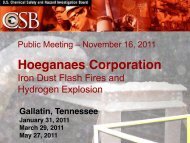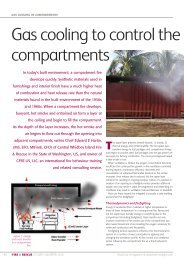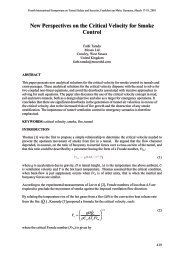fire protection of concrete structures exposed to fast fires
fire protection of concrete structures exposed to fast fires
fire protection of concrete structures exposed to fast fires
Create successful ePaper yourself
Turn your PDF publications into a flip-book with our unique Google optimized e-Paper software.
Fourth International Symposium on Tunnel Safety and Security, Frankfurt am Main, Germany, March 17-19, 2010<br />
The assessment <strong>of</strong> the residual mechanical performance <strong>of</strong> <strong>concrete</strong> slabs has been carried out on<br />
drilled cores. The cores were drilled at different locations <strong>of</strong> the slabs several months after the <strong>fire</strong> test<br />
(see Figure 9). The first operation consisted in measuring the height <strong>of</strong> the core, allowing us <strong>to</strong><br />
determine the <strong>concrete</strong> spalling depth (operation in Figure 9). Small disks were then cut from the<br />
cores; the distance "x" from the interface between <strong>concrete</strong> and thermal <strong>protection</strong> board <strong>to</strong> the upper<br />
side <strong>of</strong> the cut disk was noted (operation in Figure 9). At last, a compression test was carried out in<br />
a direction parallel <strong>to</strong> the main heat flow in the slab (operation in Figure 9). The obtained<br />
compressive strength was assumed <strong>to</strong> be representative <strong>of</strong> the residual mechanical performance <strong>of</strong> the<br />
<strong>concrete</strong> at a distance "x" from the interface.<br />
Figure 9. Schematic representation <strong>of</strong> the testing procedure for the assessment <strong>of</strong> the residual compressive<br />
strength on drilled cores from <strong>fire</strong> tested slabs (blue zones correspond <strong>to</strong> ejected <strong>concrete</strong>).<br />
The different spalling depths that were measured on drilled cores (for a same slab, we present the<br />
minimal, maximal and mean measured spalling depths) are presented in Figure 10. The results are<br />
presented for different thermal <strong>protection</strong> board thicknesses. The main observations are as following:<br />
- by comparing the measurements <strong>of</strong> <strong>concrete</strong> spalling that were done just after the <strong>fire</strong> tests<br />
(red curves in Figure 10) and the measurements <strong>of</strong> <strong>concrete</strong> spalling that were done on drilled<br />
cores (i.e. several month after <strong>fire</strong> test), we can observe that the departure <strong>of</strong> cover <strong>concrete</strong><br />
can continue even after a long period following a <strong>fire</strong>. This phenomenon is particularly true in<br />
the case <strong>of</strong> the silico-calcareous <strong>concrete</strong>. This "post-<strong>fire</strong>" <strong>concrete</strong> departure can be explained<br />
by different mechanisms (inverse thermal gradient during cooling down that induces tensile<br />
stresses in the cover <strong>concrete</strong> zones, "re-hydration" or "re-humidification" <strong>of</strong> the <strong>concrete</strong> that<br />
can result in swelling and falling <strong>of</strong> the material…) and appears as a main fac<strong>to</strong>r <strong>to</strong> take in<strong>to</strong><br />
account for the post-<strong>fire</strong> assessing <strong>of</strong> a <strong>concrete</strong> structure. Indeed, this cover <strong>concrete</strong><br />
departure can play a role for the residual mechanical performance <strong>of</strong> the structure (decrease <strong>of</strong><br />
the resistive cross-section) as well for its durability (decrease <strong>of</strong> reinforcement <strong>protection</strong><br />
regarding <strong>to</strong> aggressive fac<strong>to</strong>rs),<br />
- the measurements confirm the tendencies observed just after the <strong>fire</strong> test (see § 4.1): the<br />
absence, or the under sizing <strong>of</strong> the thermal <strong>protection</strong> (from 8 <strong>to</strong> 15 mm in our study),<br />
involves and important spalling <strong>of</strong> cover <strong>concrete</strong>. Moreover, the measurements confirm the<br />
fact that in the case <strong>of</strong> an under sized thermal <strong>protection</strong>, <strong>concrete</strong> spalling can be deeper than<br />
for a slab without <strong>protection</strong>,<br />
- a thermal <strong>protection</strong> that is correctly designed (20 and 25 mm in our study) allows avoiding<br />
<strong>concrete</strong> spalling, even after a long period after the <strong>fire</strong>.<br />
244



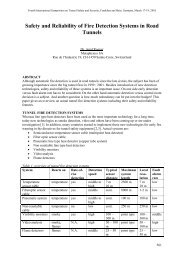
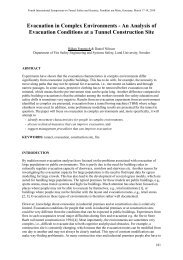
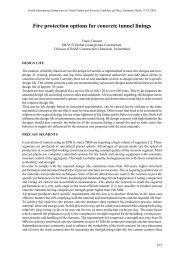
![30-37 TunnelsREV[1]rev.qxd - Industrial Fire Journal](https://img.yumpu.com/22237435/1/184x260/30-37-tunnelsrev1revqxd-industrial-fire-journal.jpg?quality=85)
